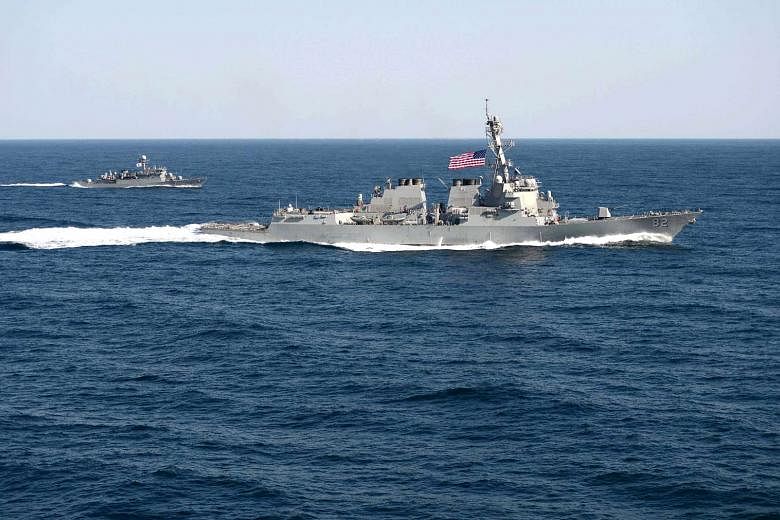BEIJING (REUTERS) - A US Navy guided-missile destroyer sailed close to China's man-made islands in the disputed South China Sea on Tuesday (Oct 27), drawing an angry rebuke from Beijing, which said its warships tracked and warned the American vessel.
The patrol by the USS Lassen was the most significant US challenge yet to the 12-nautical-mile territorial limits China asserts around the islands in the Spratly archipelago and could ratchet up tension in one of the world's busiest shipping lanes.
One US defense official said the USS Lassen sailed within 12 nautical miles of Subi Reef. A second defense official said the mission, which lasted a few hours, included Mischief Reef and would be the first in a series of freedom-of-navigation exercises aimed at testing China's territorial claims.
A Chinese guided-missile destroyer and a naval patrol ship shadowed and gave warnings to the US warship "according to law", China's Defense Ministry said in statements on its website, adding that the military would take all necessary steps to protect the country's security.
The US patrol was a "coercive action that seeks to militarize the South China Sea region" and an "abuse" of freedom of navigation under international law, it added.
China's Vice Foreign Minister Zhang Yesui summoned US Ambassador Max Baucus over the incident, calling the US patrol"extremely irresponsible," the Foreign Ministry said on its website.
The ministry earlier said the USS Lassen "illegally"entered waters near islands and reefs in the Spratlys without the Chinese government's permission. "China will resolutely respond to any country's deliberate provocations," the ministry said in a statement that gave no details on precisely where the US ship sailed.
Foreign Ministry spokesman Lu Kang later told a daily briefing that if the United States continued to "create tensions in the region," China might conclude it had to "increase and strengthen the building up of our relevant abilities".
Lu did not elaborate, except to say he hoped it did not come to that, but his comments suggested China could further boost its military presence in the South China Sea.
"China hopes to use peaceful means to resolve all the disputes, but if China has to make a response then the timing, method and tempo of the response will be made in accordance with China's wishes and needs."
The second US defense official said additional patrols would follow in coming weeks and could be conducted around features that Vietnam and the Philippines have built up in the Spratlys.
"This is something that will be a regular occurrence, not a one-off event," said the official. "It's not something that's unique to China."
White House spokesman Josh Earnest referred questions on any specific operations to the Pentagon, but said the United States had made clear to China the importance of free flow of commerce in the South China Sea.
The US Navy last went within 12 miles of Chinese-claimed territory in the Spratlys in 2012.
China claims most of the South China Sea, through which more than US$5 trillion (S$7 trillion) of world trade passes every year. Vietnam, Malaysia, Brunei, the Philippines and Taiwan have rival claims.
The Philippines, a vocal critic of China's activities in the South China Sea, welcomed the US action.
"The American passage through these contentious waters is meant precisely to say that there are norms as to what freedom-of-navigation entails and they intend to exercise (these) so there is no de facto changing of the reality on the ground," President Benigno Aquino told reporters.
RISK OF ESCALATION
The decision to go ahead with the patrol follows months of deliberation, and risks upsetting already strained ties with China. "By using a guided-missile destroyer, rather than smaller vessels ... they are sending a strong message," said Ian Storey, a South China Sea expert at Singapore's Institute of South East Asian Studies.
"They have also said, significantly, that there will be more patrols - so it really now is up to China how it will respond."
Some experts have said China would likely resist attempts to make such US actions routine. China's navy could for example try to block or attempt to surround US vessels, they said, risking an escalation.
Zhu Feng, executive director of the China Centre for Collaborative Studies of the South China Sea at Nanjing University, said he expected Beijing to limit its response as it ultimately did not want confrontation. "Both sides will be quite verbal but real actions, I hope, will show signs of exercising restraint," Zhu said.
COMPETING CLAIMS
Both Subi and Mischief Reefs were submerged at high tide before China began a dredging project to turn them into islands in 2014.
Under the UN Convention on the Law of the Sea, 12-nautical mile limits cannot be set around man-made islands built on previously submerged reefs.
Washington worries that China has built up its outposts with the aim of extending its military reach in the South China Sea. China says they will have mainly civilian uses as well as undefined defence purposes.
The patrol comes just weeks ahead of a series of Asia-Pacific summits that Presidents Barack Obama and Xi Jinping are expected to attend in the second half of November.
Xi surprised US officials after a meeting with Obama in Washington last month by saying that China had "no intention to militarise" the islands.
Even before that, however, satellite photographs had shown the construction of three military-length airstrips by China in the Spratlys, including one each on Subi and Mischief reefs.
Some US officials have said that the plan for patrols was aimed in part at testing Xi's statement on militarisation.
Pentagon officials say the United States regularly conducts freedom-of-navigation operations around the world to challenge excessive maritime claims.
In early September, China sent naval vessels within 12 miles of the Aleutian Islands off Alaska. China said they were there as part of a routine drill following exercises with Russia.

